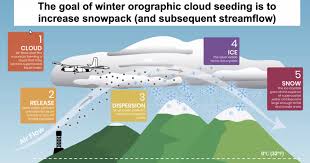Understanding Cloud Seeding: Techniques and Impact

Introduction to Cloud Seeding
Cloud seeding has emerged as an innovative approach in the field of meteorology, aimed at enhancing precipitation and managing water resources. This technique involves dispersing substances into the atmosphere that serve as cloud condensation or ice nuclei, effectively inducing rain or snow from the clouds. As global climate change intensifies and water scarcity becomes a more pressing concern, the relevance of cloud seeding cannot be overstated. Various regions around the world are using it to augment water supply, particularly in drought-prone areas.
The Science Behind Cloud Seeding
Cloud seeding began in the late 1940s, with initial experiments conducted using silver iodide and other compounds that can encourage condensation. The process typically involves aerial dispersion of these particles into suitable clouds under favorable atmospheric conditions. Recent advancements in technology have improved the precision and effectiveness of cloud seeding operations. For instance, weather-modifying flights are now equipped with advanced radar systems and specialized equipment that ensure optimal targeting of clouds expected to produce precipitation.
Current Applications and Success Stories
Cloud seeding is successfully implemented in various parts of the world. For example, the state of Nevada has adopted it as a strategy to combat the critical water shortages affecting the region. In recent projects, cloud seeding operations contributed to a measurable increase in precipitation during dry spells, providing much-needed relief to local water supplies.
Internationally, countries like the UAE have invested in large-scale cloud seeding programs to enhance rainfall in arid regions. In fact, the UAE’s National Center of Meteorology has reported significant results from its cloud seeding efforts, yielding an estimated increase of up to 30% in precipitation. Such achievements highlight the potential of cloud seeding as an essential tool in managing water resources amid climate variabilities.
Environmental Concerns and Future Outlook
Despite its benefits, cloud seeding is not without controversy. Critics raise concerns regarding the environmental impacts of introducing foreign substances into the atmosphere, potential changes to local ecosystems, and ethical implications associated with weather modification. Ongoing research is crucial to address these concerns and ensure responsible use of this technology.
Looking ahead, cloud seeding might play a significant role in sustainable water management strategies. As technology advances and further studies clarify its impacts, we may see expanded acceptance and application of cloud seeding globally. In conclusion, while cloud seeding is not a panacea for water scarcity, it represents a promising approach in addressing the challenges posed by climate change and resource shortages.









